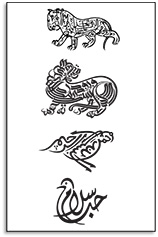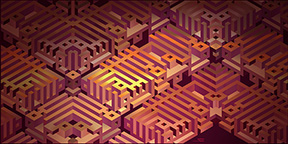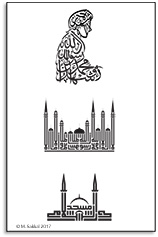Part 5 of 5 articles The Art of Arabic Calligraphy |
|||
Modern Developments© Mamoun Sakkal 2017 |
|||
Despite some decline in the demand for calligraphy in the Muslim world after the Industrial Revolution and the introduction of mechanical printing, the practice of calligraphy has persisted, and masters of the art continued to train young apprentices. After attempts to abandon the Arabic script in the first half of the 20th century and to replace it with Latin script, the art of Arabic calligraphy seems to be enjoying a revival in the last few decades of the 20th century that continues to this date. On one had we witness the continuation of traditional practices and a rising interest in collecting original and contemporary masterpieces, and on the other hand we also witness the expansion of artistic horizons of Arabic script calligraphy into new realms of practice and expression. For example, there are increasing numbers of artists who use calligraphy as painting with emphasis on emotional impact that comes from new understanding of shape, color, composition, and purpose of the artwork. Modern schools of European art often inspire this understanding, but occasionally it is rooted in traditional practices as well. For example, there is a renewed interest in using Square Kufic calligraphy in modern art and design, and both zoomorphic calligraphy where the letters and words make up the shape of a bird or an animal (Fig. 9) and figurative calligraphy where the letters and words make the shape of an identifiable object such as a building or a vase (Fig. 10), are finding fresh applications by contemporary calligraphers. These styles started as early as the 15th century and blossomed between the 17th and19th centuries. We also find calligraphers and artists who use new tools to produce their calligraphic work and consequently achieving new aesthetic forms. For example, the use of brushes instead of reed pens results in calligraphic pieces that are more free in their execution and express personal styles that remind one of Chinese rather than Arabic calligraphy. Another example is the use of computers for design and production of calligraphic pieces that allow for novel artistic treatments. One of the most exciting innovations is releasing calligraphy from its two-dimensional realm into three-dimensional space, whether in the form of actual sculpture or in the form of two-dimensional representation of calligraphy in space. This recent development adds another dimension, literally, to a rich heritage and hints at great possibilities for new modes of expression (Fig. 11).
Article and figures © copyright 2017 by Mamoun Sakkal |

Fig. 9. Samples of zoomorphic calligraphy Fig. 10. Samples of figurative calligraphy Click on image for details |
||


